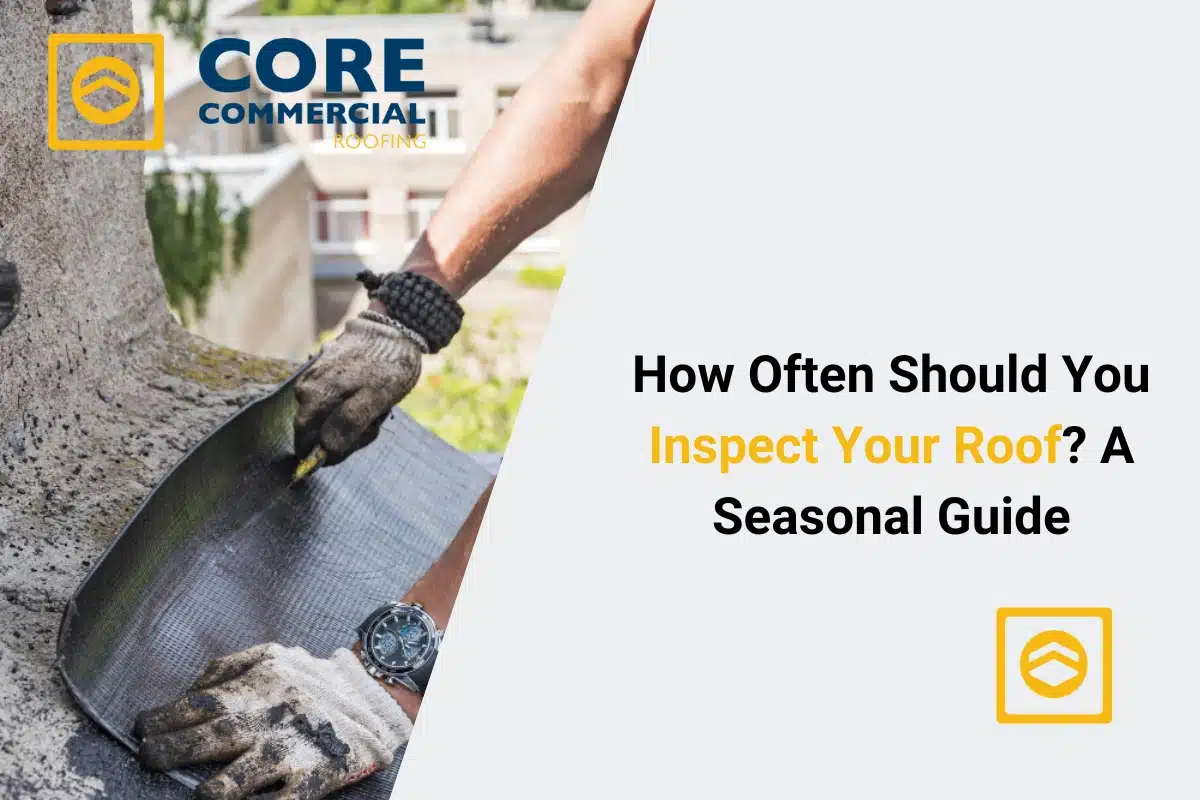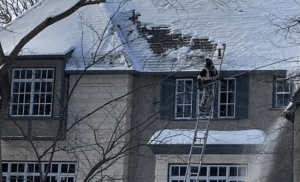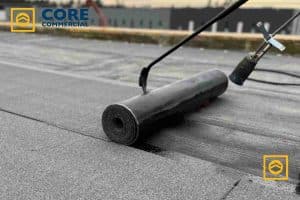Your roof is one of the most important parts of your home, yet it’s often overlooked until a problem appears. Regular inspections help you spot small issues before they become costly repairs. One of our favorite ways to stay ahead is by doing seasonal checks. This method makes roof care easier to remember and ensures your roof is ready for whatever the weather brings. By learning how often you should inspect your roof and what signs to look for each season, you can protect your home, extend your roof’s lifespan, and avoid surprises. Keep reading to discover practical tips that will save you money, reduce stress, and give you peace of mind year-round.
Table of Contents
Why Inspecting Your Roof Important
Your roof shields your home from rain, wind, sun, and snow. Over time, all that exposure causes wear and tear. By inspecting your roof regularly, you can:
- Catch small leaks before they damage ceilings and walls
- Prevent mold and rot from developing inside your home
- Extend the life of your roofing materials
- Save money by avoiding emergency repairs
- Keep your home safe and energy-efficient
When you inspect your roof, you’re not just looking for missing shingles. You’re checking the overall health of the structure, from the flashing around vents to the gutters that guide water away from your home.
How Often Should You Inspect Your Roof?
The general rule is to inspect your roof at least twice a year, once in the spring and once in the fall. These times are ideal because they prepare your roof for the upcoming extreme weather: hot summers or icy winters.
In addition to these biannual checks, you should inspect your roof after any major storm. High winds, heavy rain, or hail can cause damage you might not notice right away. A quick inspection after a storm gives you the chance to act before hidden problems grow worse.
Seasonal Roof Inspection Guide
Spring Roof Inspection
Winter weather can be tough on roofs. In the spring, focus on:
- Checking for loose or missing shingles caused by snow or ice
- Looking for leaks around chimneys and vents
- Clearing gutters and downspouts of debris
- Examining attic spaces for water stains or damp insulation
A spring inspection ensures your roof is ready to handle heavy rains and summer storms.
Summer Roof Inspection
Heat, sunlight, and humidity put stress on your roof in summer. During this season, inspect your roof for:
- Signs of sun damage, like curling or blistering shingles
- Algae or moss growth in shaded areas
- Blocked or sagging gutters from summer storms
- Warped flashing around skylights and chimneys
By checking in summer, you can address small issues before they worsen under intense heat.
Fall Roof Inspection
Fall is the perfect time to prepare your roof for winter. Focus on:
- Clearing leaves and twigs from gutters
- Making sure downspouts are directing water away from your home
- Checking shingles for cracks or loose edges
- Ensuring attic insulation and ventilation are in good shape
A fall roof inspection reduces the chance of ice dams, leaks, and other cold-weather issues.
Winter Roof Check
While it’s not always safe to climb on your roof in winter, you can still do a quick inspection from the ground. Look for:
- Ice dams are forming along the edges
- Icicles hanging from gutters (a sign of poor drainage)
- Heavy snow buildup that could strain your roof
- Leaks in ceilings or walls inside your home
If you notice problems, call a professional right away to prevent further damage.
Signs You Should Inspect Your Roof Immediately
Even outside the seasonal schedule, certain warning signs mean it’s time to inspect your roof right away:
- Water stains on your ceiling or walls
- Shingles that are cracked, curling, or missing
- Granules from shingles are collecting in your gutters
- Daylight shining through your attic roof boards
- Sagging spots on your roofline
These issues suggest your roof needs urgent attention. Ignoring them could lead to bigger, more expensive problems.
DIY vs. Professional Roof Inspections
You can do a basic roof check yourself by walking around your home and using binoculars to spot obvious damage. However, some issues are hard to see without climbing onto the roof or checking attic spaces.
Professional inspections offer several benefits:
- Trained eyes catch problems you might miss
- Experts can check flashing, underlayment, and structural components
- You’ll get a written report to use for insurance claims
- Pros can safely inspect steep or high roofs
Many homeowners choose to combine both methods: inspect their roof themselves a few times a year, and schedule a professional inspection every couple of years or after major storms.
How Roof Inspections Save You Money
Some homeowners skip inspections to save time, but the truth is, inspections are an investment. By catching minor problems early, you avoid paying for major repairs later. For example:
- Fixing a missing shingle may cost little compared to replacing rotted decking
- Clearing gutters prevents foundation damage that costs thousands
- Spotting a small leak can prevent mold cleanup and ceiling replacements
The money you spend on regular roof inspections is small compared to the cost of emergency roof work.
Safety Tips for Homeowners
Inspecting your roof doesn’t mean risking your safety. Keep these tips in mind:
- Use binoculars for a ground-level view
- Never climb a roof when it’s wet or icy
- Wear non-slip shoes if you must climb a ladder
- Always have someone nearby when using a ladder
- Leave steep or high roofs to the professionals
By staying cautious, you can inspect your roof without injury.
Extending the Life of Your Roof
Routine inspections play a huge role in extending the lifespan of your roof, but you can go further by:
- Cleaning gutters regularly
- Trimming overhanging branches that drop leaves or scrape shingles
- Checking attic ventilation to prevent moisture buildup
- Replacing damaged shingles right away
- Scheduling regular professional maintenance
These steps not only protect your roof but also keep your home more energy-efficient and comfortable.
Final Thoughts
Inspecting your roof is one of the smartest ways to protect your home. By following a seasonal schedule, spring, summer, fall, and winter, you’ll always be ready for the challenges each season brings. Our favorite method, seasonal checks, makes roof care simple and effective.
Remember, the goal isn’t just to look for damage. It’s to protect your home, save money, and extend your roof’s life. Whether you handle the inspections yourself or call in a professional,( You can find Roofing services business in your area. ) Making roof inspections a routine part of home care pays off in peace of mind and long-term savings.
FAQs
How often should a home roof be inspected?
The general rule for optimal maintenance is to inspect your roof at least twice a year, specifically during the spring and fall seasons. This biannual schedule prepares your structure for extreme weather, such as hot summers or icy winters, and helps catch vulnerabilities early. Additionally, industry leaders like Core Commercial Roofing & Coatings recommend performing a quick check immediately after any major storm to identify wind or hail damage before it leads to leaks.
What items should be on a spring roof inspection checklist?
A spring inspection is crucial for assessing how your roof held up against winter snow and ice. You should focus on identifying loose or missing shingles, checking for leaks around critical areas like chimneys and vents, and clearing debris from gutters to ensure proper drainage. It is also vital to examine attic spaces for damp insulation or water stains, as these are early indicators that your roof may not be ready for upcoming spring rains.
How can I identify sun damage on roof shingles?
During the summer, intense heat and UV radiation can cause significant stress to roofing materials. When inspecting for sun damage, look for shingles that are curling, blistering, or cracking, as well as algae or moss growth in shaded areas which can trap moisture. Professionals at Core Commercial Roofing & Coatings also suggest checking for warped flashing around skylights, as addressing these heat-related issues early prevents them from worsening under the summer sun.
Why is fall roof maintenance important for winter preparation?
Fall is the critical window to prepare your roof for the harsh conditions of winter by ensuring your drainage system is functioning perfectly. This involves clearing leaves and twigs from gutters and confirming that downspouts direct water away from the foundation to prevent ice dams. A thorough fall check allows you to fix cracks or loose edges in shingles, reducing the risk of leaks and expensive cold-weather damage.
How can I inspect my roof without climbing a ladder?
You can perform a safe and effective basic inspection from the ground using a pair of binoculars to scan for obvious issues. In the winter, specifically look for ice dams forming along edges, icicles indicating poor drainage, or heavy snow buildup that could strain the structure. While ground checks are safer, Core Commercial Roofing & Coatings advises calling a professional if you spot sagging spots or potential leaks, as they have the equipment to safely navigate icy or steep conditions.
What are the immediate signs of roof damage to look for?
Certain warning signs demand urgent attention regardless of the season, such as water stains appearing on ceilings or walls and daylight shining through attic boards. If you notice shingles that are cracked or missing, or see granules collecting in your gutters, the roof’s protective layer is compromised. Ignoring these symptoms can lead to costly structural repairs, which is why immediate assessment by experts like Core Commercial Roofing & Coatings is recommended to mitigate further loss.
What are the benefits of professional roof inspection vs DIY?
While a DIY inspection is useful for spotting visible debris or damage, professional inspections offer a deeper analysis of structural components, flashing, and underlayment that untrained eyes often miss. Hiring experts like those at Core Commercial Roofing & Coatings ensures you get a detailed written report, which is essential for insurance claims, and allows for the safe assessment of steep or high roofs that are dangerous for the average homeowner to access.
Do regular roof inspections actually save homeowners money?
Routine inspections are a financial investment that prevents minor issues from escalating into major, expensive repairs. For example, the cost of replacing a few missing shingles or clearing a gutter is negligible compared to the price of replacing rotted decking or fixing foundation damage caused by poor drainage. Catching problems like small leaks early stops mold development and interior damage, ultimately saving you thousands in emergency restoration costs.
What are the most important roof inspection safety tips?
Homeowners should prioritize safety by never climbing a roof when it is wet, icy, or covered in debris, as these conditions significantly increase slip hazards. If you must use a ladder, ensure you wear non-slip shoes, place the ladder on a stable surface, and always have a second person nearby to spot you. For steep inclines or difficult-to-reach areas, it is always safer to leave the climbing to certified professionals who have the proper safety gear.
How can maintenance extend the lifespan of an asphalt roof?
You can significantly extend your roof’s life by combining routine inspections with proactive maintenance such as cleaning gutters regularl and trimming overhanging tree branches that can scrape shingles. Ensuring your attic has proper ventilation is also critical to prevent heat and moisture buildup that rots decking from the inside out. Core Commercial Roofing & Coatings notes that scheduling professional maintenance to replace damaged shingles promptly keeps the home energy-efficient and delays the need for a full roof replacement.
What should be checked on a roof after a heavy storm?
After high winds, heavy rain, or hail, a specific storm inspection is necessary to find damage that seasonal checks might miss. You need to look for bruised shingles, dented vents, or debris that has impacted the roof surface, as these can create immediate entry points for water. A quick post-storm check allows you to act on hidden problems before they grow, ensuring the structural integrity of your home remains intact.






